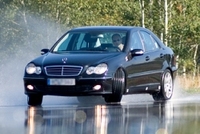Touring Club Schweiz Runs Comparative Test of Tyre Concepts: "All-season Tyres are a Poor Compromise"
HANOVER, GERMANY – May 4, 2009: In its controversial test, Touring Club Schweiz (TCS), the Swiss Touring Club, took a closer look at the driving performance of summer, all-season and winter tyres. The conclusion?
All-season tyres increase fuel consumption, wear more rapidly, and have longer braking distances in both summer and winter - in addition, they are considerably more expensive to buy than their counterparts for the respective seasonal weather conditions.
When they compared the driving performance, the experts at TCS already noted that in the warm weather, summer tyres offer substantial advantages over all-season tyres, and the same applies to winter tyres in cold weather. A car fitted with summer tyres, for example, needed 38 metres to come to a halt from a speed of 100 km/h on a dry road - the braking distance of an identical car fitted with all-season tyres was 14 metres longer. "What made it dangerous was that at the point where the car with summer tyres had stopped, the one with all-season tyres was still moving at a residual speed of 52 km/h" explained Marcel Bachmann, head of the tyre tests at TCS.
The tests carried out on snow-covered roads proved equally controversial - the braking distance of a car with all-season tyres was 13 metres longer than that of one fitted with winter tyres, and here the residual speed was 22 km/h (comparison in each case with braking from a speed of 40 km/h). Even tests on wet roads revealed that an all-season tyre has substantial safety flaws. When braking from a speed of 80 km/h in warm weather, it required 7 metres more than a summer tyre and in cold weather, its braking distance was 4 metres longer than that of a winter tyre. Here again, the residual speed was the dangerous aspect - when the summer tyre had come to a halt, the all-season tyre was still doing 31 km/h, and when the winter tyre had stopped, the all-season tyre was doing 24 km/h. At this speed, pedestrians or cyclists would suffer at least serious, if not irreversible injuries in the case of a collision; the car passengers would probably also be injured.
The TCS also advises bargain hunters, unimpressed by driving performance, against buying all-season tyres, as a set of these tyres costs considerably more than what they would pay for summer and winter tyres together. These tyres would also increase their fuel consumption by around 5% and the mileage performance of all-season tyres is 10-15% poorer than that of either summer or winter tyres. Even when allowing for the costs of switching tyres each year, the experts also came up with savings of around 330 euros (500 SFr) for those motorists with the correct tyres for the respective season. The conclusion of the TCS experts: "All-season tyres are a poor compromise". In the test, the TCS did not evaluate individual tyres; it based its findings on the most balanced products among the summer, winter and all-season tyres featured in current tyre tests run by the TCS, the German motoring organisation ADAC and its Austrian counterpart ÷AMTC.



